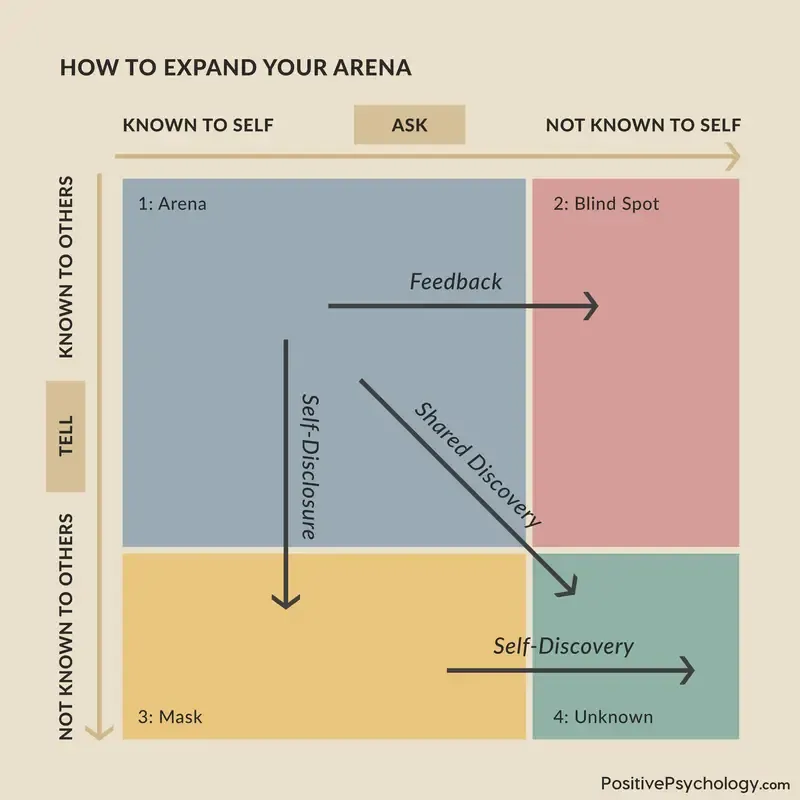17 Self-Discipline Exercises to Help Build Self-Control
 Every day we deal with distractions, struggle to concentrate, and do our best not to procrastinate.
Every day we deal with distractions, struggle to concentrate, and do our best not to procrastinate.
Whether we’re trying to study for a test, lose weight, kick a bad habit, or work toward a future goal, willpower always plays a part.
So why do some people ‘stick at it’ so much better than others? What’s their secret, and how can you learn to cultivate more self-discipline?
This article covers self-discipline theory and the evolution of the concept, to answer some of your most common questions about willpower.
Keep reading to learn more about the techniques, skills, and activities that can help you build better self-discipline and take more control of your everyday life.
Before you continue, we thought you might like to download our three Productivity Exercises for free. These detailed, science-based exercises will help you or your clients become more productive and efficient.
This Article Contains:
- What Is Self-Discipline Theory?
- Common Questions About Self-Discipline
- 4 Important Techniques and Skills We Should Know
- A Look at Self-Discipline in Kids
- 5 Ideas for Building Self-Discipline in Children
- 5 Exercises, Activities, and Worksheets Designed to Improve Self-Discipline
- 3 Tests and Questionnaires
- A Take-Home Message
- References
What Is Self-Discipline Theory?
What is self-discipline, and how does it work? Many of us feel like we don’t have enough of it or want to improve it, but can we develop it? Let’s start with a definition of self-discipline and look a little closer at the theory behind it.
Defining self-discipline
In the psychological literature, self-discipline is often called self-control or willpower: “effortful regulation of the self by the self” (Duckworth, 2011, p. 2639). We’ll be using the terms interchangeably in this article.
It is also defined as “the ability to suppress prepotent responses in the service of a higher goal… and that such a choice is not automatic but rather requires conscious effort” (Duckworth & Seligman, 2006, p. 199).
The American Psychological Association provides a nice overview of a few key self-discipline characteristics that have been used by psychologists, including (Metcalfe & Mischel, 1999; Tangney, Baumeister, & Boone, 2004; Moffitt et al., 2011):
- The ability to quash an impulsive response that undoes our commitment
- The capacity to delay gratification, holding out against short-term temptations so we can meet longer term goals
- The ability to use “cool” rather than a “hot” emotional system of behavior
Self-discipline theory
There are numerous different theories about how self-discipline works and how we can tap into it to accomplish our goals.
Ego depletion
One of the most well-supported willpower theories concerns ego depletion: the idea that willpower is limited and we rely on a finite reservoir of mental resources to resist temptation (Baumeister, Bratslavsky, Muraven, & Tice, 1998; Muraven & Baumeister, 2000; Gino, Schweitzer, Mead, & Ariely, 2011).
According to this theory, we use willpower daily to resist urges and push ourselves, until those resources dwindle or run out.
Say we’ve stopped ourselves from yelling at a coworker in the morning, chosen fruit instead of chocolate at 3:00 p.m., and held back from the bread rolls before dinner. This theory would view such acts as depleting events. At the end of it, we theoretically have fewer mental resources to resist continued urges. We might then skip the gym in our ‘weakened state’ or take a cab home instead of walking.
Support for ego depletion theory
Early empirical support for ego depletion theory included the famous ‘cookie’ experiment conducted by Baumeister et al. (1998). In this study, participants were asked to choose between snacking on cookies or radishes. Guess which one required more willpower?
Afterward, they were given a puzzle to solve – an unsolvable puzzle, but they didn’t know it – to observe which group of participants would persevere longer. As the researchers predicted, those who had snacked on cookies persisted 11 minutes longer than those who had resisted them.
Some interesting, but now disproven, extensions on this theory included the idea that willpower was related to our body’s glucose supply. The original idea was that when sugar levels dropped, so did our self-discipline (Donohoe & Benton, 1999, 2000; Gailliot & Baumeister, 2007).
Evidence to the contrary
Since the early ‘90s, researchers have presented other findings that question the validity of Baumeister et al.’s (1998) ego-depletion theory. Rather than relying on a finite supply of willpower, there is evidence that our attitudes and beliefs may have a moderating influence on our self-discipline (Muraven & Slessareva, 2003; Muraven, Gagné, & Rosman, 2008; Job, Walton, Bernecker, & Dweck, 2013).
Muraven and Slessareva (2003) showed that ‘depleted’ participants could compensate for lower self-control resources through higher motivation, even performing as well as non-depleted participants with high motivation.
And as the authors so aptly describe, this “can help explain why, when depleted, people may lose control of their appetites but not their temper” (Muraven & Slessareva, 2003, p. 906).
Another study demonstrated that participants who believed self-control was plentiful and unlimited had high willpower performance, both with and without glucose boosts (Job et al., 2013). Participants who believed in finite and easily depleted willpower, however, performed poorly on experimental tasks as the demands on their self-control grew.
Both motivation and self-control resources are essential components of self-control (Muraven & Slessareva, 2003).
Common Questions About Self-Discipline
Now that we’ve explained what self-discipline is, let’s get into why it’s important and how you might be able to improve it.
Here’s what the research says.
Why is self-discipline important?
Willpower helps us resist short-term urges and impulses to pursue longer term goals. If you’re saving for a car, for instance, practicing self-control about impulse purchases can help you save more easily and quickly.
Mischel and Ebbesen’s (1970) early marshmallow experiment was one of the first studies into delayed gratification, and it gave rise to a surge of later studies linking self-discipline with success.
A couple of decades later, researchers followed up with the students from the marshmallow experiment and found that those who could delay gratification had comparatively better academic performance and higher educational achievements than those who couldn’t (Shoda, Mischel, & Peake, 1990).
This corresponds with later findings that have shown self-control to have a more significant positive impact on academic success than cognitive intelligence, and that students with more self-discipline had better grades, school attendance, and test results (Duckworth & Seligman, 2006).
Research findings also point to the parts that self-control can play in:
- Reduced risk of obesity – due in part to higher impulse control and the ability to delay gratification (Tsukayama, Toomey, Faith, & Duckworth, 2010)
- Better muscular and aerobic fitness (Kinnunen, Suihko, Hankonen, Absetz, & Jallinoja, 2012)
- Lower likelihood of engaging in risky or criminal behaviors (King, Fleming, Monahan, & Catalano, 2011; Ford & Blumenstein, 2012)
- Greater occupational and career achievement in terms of income and job satisfaction (Converse, Piccone, & Tocci, 2014).
4 Important Techniques and Skills We Should Know
So how can we develop more self-control? Let’s look at some techniques that may be helpful.
1. Develop your self-awareness
How many temptations do you think you resist every day?
It’s impossible to know, because most of our decisions are unconscious. By becoming more attuned to when, where, and how we exercise self-control, we can start to manage our behavior a little better.
For example, have you ever gone to the supermarket when you’re really hungry? If so, chances are you made a few more impulse buys than you would have if you’d gone on a full stomach. There are many benefits of self-awareness. Being aware of what we do when we’re doing it is the first step to making better decisions and resisting those that don’t help us over the long term.
As a start, we can try to recognize and avoid temptation, either by steering clear of it or distracting ourselves from it (Metcalfe & Mischel, 1999).
2. Believe in willpower
The beliefs that we hold about willpower can affect our ability to practice self-control (Job et al., 2013).
By viewing self-discipline as an unlimited resource, participants were able to exercise the same degree of willpower after a depleting task as before it, demonstrating the impact our beliefs can have on our actions (Job et al., 2013).
This suggests that you and I can do the same. Choosing not to view self-control as a depletable resource might give us some of the motivation we need to overcome, at least mild cases of, ego depletion (Vohs, Baumeister, & Schmeichel, 2012).
3. Regular physical exercise

They also reported positive increases and improvements in other domains related to self-discipline: emotional control, spending, study habits, attendance to commitments, healthy eating, and household chores. At the same time, they reported significant reductions in perceived stress and unhealthy habits, such as smoking and caffeine consumption (Oaten & Cheng, 2006).
4. Implementation intention
Practicing the implementation intention technique can help you improve your self-control, work toward breaking bad habits, and change unwanted behavior (Gollwitzer, 1999). The method involves creating an if–then plan that specifies when, where, and how you’ll act to achieve a goal.
Implementation intention has been shown to increase the likelihood of goal achievement by helping us bridge the gap between our goal intentions and our behaviors (Gollwitzer & Brandstaetter, 1997). By identifying and committing to concrete goals, then specifying the precise goal-directed behaviors we’ll engage in, we help to make this behavior more automatic when the time comes.
In the next section, we’ve given you an introduction to an implementation intention exercise.
The Johari Window is a thought-provoking self-awareness framework founded by Luft & Ingham (1955). It brings recognition to how you are perceived by others, and also encourages the expansion of your self-awareness.
The Johari Window consists of four quadrants, namely the Arena, the Blind Spot, the Mask, and the Unconscious.
- The Arena: This quadrant includes not only self-knowledge but public knowledge about your personality, skills, attitudes, and behaviors.
- The Blind Spot: This facet includes the things that are blatantly obvious to those around us, but we have yet to recognize in ourselves.
- The Mask: This includes hidden information that you have concealed from others for a multitude of reasons. This information is usually disclosed once you have built a trusting relationship with someone.
- The Unconscious: This quadrant includes undiscovered truths, talents, and information about yourself that can be uncovered through introspection.
Introspection involves looking inward to understand our internal thought processes, beliefs, and sensory experiences (Schwitzgebel, 2012).
For example, according to the Johari Window framework, minimizing the blind spot by receiving feedback from others is not an example of introspection. Although it is gaining self-awareness and self-knowledge, it is not a purely internal process.
The unknown and unconscious quadrant can only be minimized by the means of self-discovery. Self-discovery is a multifaceted approach which can be done through self-monitoring (noticing what is going on in our minds), mindfulness, or asking yourself introspective reflection question (Schwitzgebel, 2012).
A Look at Self-Discipline in Kids
We’ve heard of Mischel and Ebbesen’s (1970) marshmallow study (if you haven’t, read our delayed gratification article), but what else do we know about self-discipline in kids?
Here’s an overview of some key research findings to date (Makin, 2013):
- In 1972, the influential marshmallow study demonstrated that kids waited an average of 6 minutes before eating a marshmallow that was placed in front of them, despite being told that they could have two marshmallows if they waited 15 minutes. Kids who delayed gratification for longer did so by either hiding the marshmallow or distracting themselves.
- Almost a decade later, a similar experiment was carried out on pigeons by researchers Grosch and Neuringer (1981). Pigeons who could distract themselves during the waiting period were more likely to exercise self-control by waiting for a preferred food vs. instantly eating an inferior one (Vanderveldt, Oliveira, & Green, 2016).
- Close to 16 years after the marshmallow study, the delayed gratification children from the experiment were shown to have better academic success, SAT scores, and social and emotional competence than those who showed low self-discipline (Shoda et al., 1990).
- In 2005, researchers suggested children don’t understand the impact of conflicting mental states on their behavior until they are at least seven years old (Choe, Keil, & Bloom, 2005). Researchers propose that maybe this is because they can only observe behavior that corresponds to one of their desires (Wellman, 1990).
- Children’s ability to delay gratification at 4 years old has been linked to their obesity risk at 11 years old (Seeyave et al., 2009).
- Brain imaging research of the original marshmallow study participants in middle age showed that prefrontal cortex and ventral striatum activity differed between high and low delayers facing temptation (Casey et al., 2011).
- Kid’s ability to demonstrate self-discipline is moderated by their beliefs about the environment. More specifically, children who believed their environments were unreliable waited significantly less time to succumb to gratification than those who thought the environment was reliable (Kidd, Palmeri, & Aslin, 2013).
- Kids with low self-control during childhood are more likely to smoke throughout adulthood; over half of this relationship was attributed to adolescent smoking (Daly, Egan, Quigley, Delaney, & Baumeister, 2016).
In a nutshell, it appears that self-discipline, or delayed gratification, at least, is not as straightforward as it seems. There is evidence suggesting that low or high self-control in childhood can have influences on our choices and behaviors in later life, but that our beliefs regarding the environment can play a significant role, too.
Given that our capacity for self-control can be improved, how can we build more self-discipline in children?
5 Ideas for Building Self-Discipline in Children

According to this framework, self-discipline is viewed more as emotional self-regulation than simple delayed gratification.
It suggests that we have two processing systems:
- A cool, rational cognitive system — This helps us make more strategic, objective, and thoughtful decisions, and it underpins self-regulation or self-control.
- A hot, impulsive, emotional system that undermines the former
Using this paradigm, building self-control is about helping kids develop their capacity to use cool processes. Here are a few ideas:
1. Build trust
A trusting environment is viewed as more reliable (Kidd et al., 2013).
Think of a child experiencing homelessness who is asked by an unfamiliar experimenter to wait before eating a hot meal, versus a child whose wealthy mom asks them to wait. The former, accustomed to a shifting environment where their food could be stolen, might be less likely to wait than the latter.
The role of trust in self-discipline has also been examined by Michaelson, de la Vega, Chatham, and Munakata (2013), who found that participants were more likely to choose hypothetical immediate, smaller rewards from character vignettes they considered low in trustworthiness.
2. Encourage children to practice
Delayed gratification and cool-system activation has been linked to higher right prefrontal cortex activity, and we can strengthen this brain area through repeated practice (Casey et al., 2011). Within reason, we can give kids the chance to practice delayed gratification, exercise their prefrontal cortex’s neural pathways, and enhance their capacity for self-discipline.
3. Provide motivation
Motivation plays a significant role in self-control. Muraven and Slessareva’s (2003) participants were more likely to persist at a task when they believed doing so would help others or when they were told they’d be paid.
Providing the right motivation for children can be one way to make willpower exertion a voluntary choice rather than a chore.
You might encourage them with praise and recognition while helping them see the benefits of self-discipline through empathy. “I understand that you’re not tired now, and I’ve been there before. But I have gone to bed early before many times, and the next day I always feel energetic for the picnic!”
4. Model good behaviors
Show your child how to manage their hot-system processes by demonstrating good behavior. If you lose your temper every time someone cuts you off in traffic, they are more likely to learn that this kind of response is okay.
Visibly practicing soothing and calming positive self-talk can help them pick up techniques and skills that they can apply later (Meichenbaum & Goodman, 1971).
5. Reward desired behaviors
Positive reinforcement is also a good way to encourage acts of self-control, and rewards can be good incentives for new adaptive behaviors. Think about how you might reinforce kids with attractive rewards such as staying up five minutes longer, screen time, or stickers. Use this set of Kid’s Reward Coupons to help!
5 Exercises, Activities, and Worksheets to Improve Self-Discipline

1. Increasing self-control through repeated practice
On average, we resist two impulses out of every five that we face daily (Muraven, Baumeister, & Tice, 1999). In other words, we spend more than half our waking hours trying to resist our urges and impulses. When we don’t resist them, statistics suggest that we act on up to 70% of those desires; but when we do resist, we can decrease that figure to as little as 17%.
By practicing self-control, we can build up our willpower just as we build up fitness by exercising. To cite Muraven et al.’s (1999) figures, we can improve our self-discipline with as little as two weeks of consistent practice. Here’s a worksheet that helps you take it step by step, by performing small acts of self-control in your everyday life.
Click here to get this exercise from our Positive Psychology Toolkit©.
2. Implementation Intention
As discussed, implementation intention (if–then approaches to planning) can be a concrete and effective method for connecting your behaviors to desired outcomes. In other words, they bridge the gap between intentions and actions, leaving us with more mental resources for avoiding distractions and competing goals (Gollwitzer, 1999; Achtziger, Gollwitzer, & Sheeran, 2008).
Use this exercise to learn more about the theory behind if–then statements, then clarify what you want to achieve (your intention). As you follow the steps, you’ll plan when, where, and how you’ll start acting toward your goal, as well as how you’ll overcome obstacles: “If X happens, then I will do Y.”
Click here to get this exercise from our Positive Psychology Toolkit©.
3. The Spheres of Personal Control
If we believe that our capacity for self-control is unlimited, we can motivate ourselves to practice more willpower even when our mental resources are depleted. But that doesn’t warrant wasting time and energy trying to control factors that we can’t, such as natural disasters or another person’s behavior. This can end up having detrimental effects on our mental health (Wenzlaff & Wegner, 2000).
Here is a tool that works by helping you cultivate more self-awareness about what lies outside your sphere of personal control so that you can apply your mental resources more strategically and thoughtfully.
First, you’ll think of a valued goal you want to achieve and the desired outcomes of accomplishing it. Then, you’ll identify the actions you need to take to achieve it, before distinguishing between those that you can and cannot control.
The PDF includes more on the research and theory behind this exercise, as well as tables to fill in and examples to guide you. You can access the Spheres of Personal Control here.
4. Red Light: Anger!
Parents and teachers can use this exercise with children who find it tough to control their anger. It gives a small description of how anger starts small and grows to become bigger and often harder to control. Kids are invited to draw what they think their anger looks like in both scenarios.
The final page shows a bright red “Stop” signal. The instructions ask the child to think of the warning signs that indicate their anger is growing.
These help them understand when to pause and practice self-control before the situation gets out of hand. Then they can write their anger stop signs in the boxes. Examples include “I start to sweat,” “I want to throw something,” and “My voice gets louder.”
Download this free Red Light: Anger! worksheet.
5. Self-Control Spotting
In this exercise, children can read and think about some examples of self-discipline and its opposite. There are eight boxes at the bottom of the page for kids to cut out, including examples such as:
- “You feel sad, so you write in your diary.”
- “You feel upset, so you scream out loud.”
- “You feel angry, so you shout at your friend.”
Above this, there’s a larger table with two columns: “This Is Self-Control” and “This Is NOT Self-Control.” Kids are prompted to cut out the examples and place them where they feel they belong in the two columns. It’s designed to help children build self-awareness about how self-discipline looks and feels so they can start to improve their own capacity.
Here’s a link to the Self-Control Spotting worksheet.
The secret to self control – Jonathan Bricker
3 Tests and Questionnaires
Besides waiting around for marshmallows, how can we measure self-control? There are almost as many measures of the concept as there are definitions for it, but they fall into a few categories (Duckworth & Kern, 2011):
- Executive function tasks assess the ability to exercise top-down control over lower level cognitive processes (Williams & Thayer, 2009). Examples include Stroop tasks, set switching tasks, and continuous performance tasks.
- Delayed gratification tasks are exactly what they sound like, and this category includes hypothetical choice delay tasks (Michaelson et al., 2013), real choice tasks (like the marshmallow test), and sustained delay tasks (Grosch & Neuringer, 1981).
- Self- and informant-report personality questionnaires include standalone assessments and measures featuring multiple sub-scales.
If you’d like to look more into the latter, which you can often do yourself, have a look into some of the examples below (Duckworth & Kern, 2011) and read our blog post on Delayed Gratification Exercises.
1. The Tangney Self-Control Scale (SCS)
Developed by Tangney et al. (2004), the SCS is a 36-item measure that uses a 5-point scale. It assesses five dimensions: a general capacity for self-discipline, healthy habits, deliberate/nonimpulsive action, reliability, and work ethics (Unger, Bi, Xiao, & Ybarra, 2016).
Example items include:
- Sometimes I can’t stop myself from doing something, even if I know it is wrong.
- I have worked or studied all night at the last minute.
- People can count on me to keep on schedule.
- I am good at resisting temptation.
- I do certain things that are bad for me if they are fun.
2. The Eysenck I7 Impulsiveness Scale
This measure features items about impulsively doing and saying things and can be seen as a somewhat narrow measure of self-control (Eysenck, Easting, & Pearson, 1984; Duckworth & Kern, 2011).
Nonetheless, it’s a hefty instrument that includes 77 yes/no questions.
Examples include:
- Do you sometimes put down the first answer that comes into your head during a test and forget to check it later?
- When you watch a favorite TV show, can you feel with the hero or heroine when they are sad, happy, or angry?
- At a fairground, would you prefer playing games and seeing shows to riding rides?
- Do you get so carried away by new and exciting ideas that you never think of possible snags?
- Would you prefer an unexpected outing to one you have looked forward to for a while?
3. Barratt Impulsiveness Scale Version 11 (BIS-11)
This is a multi-scale instrument incorporating items that measure non-planning, cognitive, and motor impulsiveness (Barratt, 1985). Developed as a multifaceted assessment of trait impulsivity, it has been widely used in the field for over 50 years.
The 30-item BIS-11 measures 6 correlated components: attention, cognitive instability, motor impulsiveness, perseverance, cognitive complexity, and self-control. Sample items include the following (1 = Rarely/Never; 2 = Occasionally; 3 = Often; and 4 = Almost Always/Always):
- I am restless at the theater or lectures.
- I often have extraneous thoughts when thinking.
- I spend or charge more than I earn.
- I can think only about one thing at a time.
- I say things without thinking.
- I am more interested in the present than in the future.
A Take-Home Message
Temptation is everywhere, but by practicing self-control, we can learn to strengthen it. Self-awareness, motivation, the right mindset, and greater willpower can all help us build better self-discipline, which in turn can have potential benefits for our success and long-term goals.
Have you had any struggles with willpower today? How did you manage? How about strategies for success? Can you share any with us? Try some of the exercises, techniques, and approaches we’ve shared today, then let us know how it goes. Share your experiences in the comments!
We hope you enjoyed reading this article. Don’t forget to download our three Productivity Exercises for free.
- Achtziger, A., Gollwitzer, P. M., & Sheeran, P. (2008). Implementation intentions and shielding goal striving from unwanted thoughts and feelings. Personality and Social Psychology Bulletin, 34(3), 381–393.
- Barratt, E. S. (1985). Impulsive subtraits: Arousal and information processing. In J. T. Spence & C. E. Izard (Eds.), Motivation, emotion, and personality (pp. 137–146). Elsevier Science Publishers.
- Baumeister, R. F., Bratslavsky, E., Muraven, M., & Tice, D. M. (1998). Ego depletion: Is the active self a limited resource? Journal of Personality and Social Psychology, 74(5), 1252–1265.
- Casey, B. J., Somerville, L. H., Gotlib, I. H., Ayduk, O., Franklin, N. T., Askren, M. K., … Shoda, Y. (2011). Behavioral and neural correlates of delay of gratification 40 years later. Proceedings of the National Academy of Sciences of the United States of America, 108(36), 14998–15003.
- Choe, K. S., Keil, F. C., & Bloom, P. (2005). Children’s understanding of the Ulysses conflict. Developmental Science, 8(5), 387–392.
- Converse, P. D., Piccone, K. A., & Tocci, M. C. (2014). Childhood self-control, adolescent behavior, and career success. Personality and Individual Differences, 59, 65–70.
- Daly, M., Egan, M., Quigley, J., Delaney, L., & Baumeister, R. F. (2016). Childhood self-control predicts smoking throughout life: evidence from 21,000 cohort study participants. Health Psychology, 35(11), 1254–1263.
- Donohoe, R. T., & Benton, D. (1999). Blood glucose control and aggressiveness in females. Personality and Individual Differences, 26(5), 905–911.
- Donohoe, R. T., & Benton, D. (2000). Glucose tolerance predicts performance on tests of memory and cognition. Physiology & Behavior, 71(3-4), 395–401.
- Duckworth, A. L. (2011). The significance of self-control. Proceedings of the National Academy of Sciences of the United States of America, 108(7), 2639–2640.
- Duckworth, A. L., & Kern, M. L. (2011). A meta-analysis of the convergent validity of self-control measures. Journal of Research in Personality, 45(3), 259–268.
- Duckworth, A. L., & Seligman, M. E. (2006). Self-discipline gives girls the edge: Gender in self-discipline, grades, and achievement test scores. Journal of Educational Psychology, 98(1), 198–208.
- Eysenck, S. B., Easting, G., & Pearson, P. R. (1984). Age norms for impulsiveness, venturesomeness and empathy in children. Personality and Individual Differences, 5(3), 315–321.
- Ford, J., & Blumenstein, L. (2012). Self-control and substance use among college students. Journal of Drug Issues, 43(1), 56–58.
- Gailliot, M. T., & Baumeister, R. F. (2007). The physiology of willpower: Linking blood glucose to self-control. Personality and Social Psychology Review, 11(4), 303–327.
- Gino, F., Schweitzer, M. E., Mead, N. L., & Ariely, D. (2011). Unable to resist temptation: How self-control depletion promotes unethical behavior. Organizational Behavior and Human Decision Processes, 115(2), 191–203.
- Gollwitzer, P. M., & Brandstaetter, V. (1997). Implementation intentions and effective goal pursuit. Journal of Personality and Social Psychology, 73(1), 186–199.
- Gollwitzer, P. M. (1999). Implementation intentions: Strong effects of simple plans. American Psychologist, 54(7), 493–503.
- Grosch, J., & Neuringer, A. (1981). Self-control in pigeons under the Mischel paradigm. Journal of the Experimental Analysis of Behavior, 35(1), 3–21.
- Job, V., Walton, G. M., Bernecker, K., & Dweck, C. S. (2013). Beliefs about willpower determine the impact of glucose on self-control. Proceedings of the National Academy of Sciences of the United States of America, 110(37), 14837–14842.
- Kidd, C., Palmeri, H., & Aslin, R. N. (2013). Rational snacking: Young children’s decision-making on the marshmallow task is moderated by beliefs about environmental reliability. Cognition, 126(1), 109–114.
- King, K. M., Fleming, C. B., Monahan, K. C., & Catalano, R. F. (2011). Changes in self-control problems and attention problems during middle school predict alcohol, tobacco, and marijuana use during high school. Psychology of Addictive Behaviors, 25(1), 69–79.
- Kinnunen, M., Suihko, J., Hankonen, N., Absetz, P., & Jallinoja, P. (2012). Self-control is associated with physical activity and fitness among young males. Behavioral Medicine, 38(3), 83–89.
- Luft, J., & Ingham, H. (1955). The Johari window: A graphic model of interpersonal awareness. Proceedings of the western training laboratory in group development, (1), 46-49.
- Makin, S. (2013). A marshmallow in the hand: Delaying gratification is not always the rational choice. SA Mind, 24(1), 8.
- Meichenbaum, D. H., & Goodman, J. (1971). Training impulsive children to talk to themselves: A means of developing self-control. Journal of Abnormal Psychology, 77(2), 115–126.
- Metcalfe, J., & Mischel, W. (1999). A hot/cool-system analysis of delay of gratification: Dynamics of willpower. Psychological Review, 106(1), 3–19.
- Michaelson, L., de la Vega, A., Chatham, C., & Munakata, Y. (2013). Delaying gratification depends on social trust. Frontiers in Psychology, 4, 355.
- Mischel, W., & Ebbesen, E. B. (1970). Attention in delay of gratification. Journal of Personality and Social Psychology, 16(2), 329.
- Moffitt, T. E., Arseneault, L., Belsky, D., Dickson, N., Hancox, R. J., Harrington, H., … Sears, M. R. (2011). A gradient of childhood self-control predicts health, wealth, and public safety. Proceedings of the National Academy of Sciences of the United States of America, 108(7), 2693–2698.
- Muraven, M., & Baumeister, R. F. (2000). Self-regulation and depletion of limited resources: Does self-control resemble a muscle? Psychological Bulletin, 126(2), 247–259.
- Muraven, M., & Slessareva, E. (2003). Mechanisms of self-control failure: Motivation and limited resources. Personality and Social Psychology Bulletin, 29(7), 894–906.
- Muraven, M., Baumeister, R. F., & Tice, D. M. (1999). Longitudinal improvement of self-regulation through practice: Building self-control strength through repeated exercise. The Journal of Social Psychology, 139(4), 446–457.
- Muraven, M., Gagné, M., & Rosman, H. (2008). Helpful self-control: Autonomy support, vitality, and depletion. Journal of Experimental Social Psychology, 44(3), 573–585.
- Oaten, M., & Cheng, K. (2006). Longitudinal gains in self-regulation from regular physical exercise. British Journal of Health Psychology, 11(4), 717–733.
- Schwitzgebel, E. (2012). A defense of drinking alone. Philosophy Now, (91), 34-35.
- Seeyave, D. M., Coleman, S., Appugliese, D., Corwyn, R. F., Bradley, R. H., Davidson, N. S., … Lumeng, J. C. (2009). Ability to delay gratification at age four years and risk of overweight at age 11 years. Archives of Pediatrics & Adolescent Medicine, 163(4), 303–308.
- Shoda, Y., Mischel, W., & Peake, P. K. (1990). Predicting adolescent cognitive and self-regulatory competencies from preschool delay of gratification: Identifying diagnostic conditions. Developmental Psychology, 26(6), 978–986.
- Tangney, J., Baumeister, R., & Boone, A.L. (2004). High self-control predicts good adjustment, less pathology, better grades, and interpersonal success. Journal of Personality, 72(2), 271–324.
- Tsukayama, E., Toomey, S. L., Faith, M. S., & Duckworth, A. L. (2010). Self-control as a protective factor against overweight status in the transition from childhood to adolescence. Archives of Pediatrics & Adolescent Medicine, 164(7), 631–635.
- Unger, A., Bi, C., Xiao, Y. Y., & Ybarra, O. (2016). The revising of the Tangney Self-Control Scale for Chinese students. PsyCh Journal, 5(2), 101–116.
- Vanderveldt, A., Oliveira, L., & Green, L. (2016). Delay discounting: Pigeon, rat, human – Does it matter? Journal of Experimental Psychology: Animal Learning and Cognition, 42(2), 141–162.
- Vohs, K. D., Baumeister, R. F., & Schmeichel, B. J. (2012). Motivation, personal beliefs, and limited resources all contribute to self-control. Journal of Experimental Social Psychology, 48(4), 943–947.
- Wellman H. M. (1990). The child’s theory of mind. MIT Press.
- Wenzlaff, R. M., & Wegner, D. M. (2000). Thought suppression. Annual Review of Psychology, 51, 59–91.
- Williams, P. G., & Thayer, J. F. (2009). Executive functioning and health: Introduction to the special series. Annals of Behavioral Medicine, 37(2), 101–105.
Let us know your thoughts
Read other articles by their category
- Body & Brain (42)
- Coaching & Application (56)
- Compassion (26)
- Counseling (50)
- Emotional Intelligence (24)
- Gratitude (17)
- Grief & Bereavement (21)
- Happiness & SWB (39)
- Meaning & Values (25)
- Meditation (20)
- Mindfulness (44)
- Motivation & Goals (43)
- Optimism & Mindset (32)
- Positive CBT (25)
- Positive Communication (20)
- Positive Education (44)
- Positive Emotions (30)
- Positive Leadership (13)
- Positive Psychology (32)
- Positive Workplace (33)
- Productivity (16)
- Relationships (42)
- Resilience & Coping (34)
- Self Awareness (20)
- Self Esteem (36)
- Software & Apps (22)
- Strengths & Virtues (30)
- Stress & Burnout Prevention (33)
- Theory & Books (44)
- Therapy Exercises (35)
- Types of Therapy (58)






What our readers think
I feel like I have somewhat of self control when I a really stressed about anything I brake down and cry I just overthink anything possible but I feel like if I took the time to breath and figer it out one step at a time that I wouldn’t get so worked up about thing that stress me out.
Great job again Catherine! You are the absolute best :-)!!
Thank you for the article. Findings of Some wonderful research was put together very well. Keep up the great work
This article is exactly what I’ve been looking for. Thank you so much for sharing!
The article is indeed great ! But I wonder are self-discipline and self-control two words of the same thing?
Hi Jack,
So glad you enjoyed the article. Yes, you raise a good point about the difference between these two overlapping concepts. It’s a subtle distinction which is explained well in this article.
– Nicole | Community Manager
Thanks for a wonderful article! It was well explained and I really find it very helpful. Thanks again!
Hi Marj,
So glad you enjoyed the article. Thanks for being a reader.
– Nicole | Community Manager
As an early childhood educator, I find this article useful particularly on the use of motivation, for example, praising. Further, paying attention to desirable behaviors always works for me . Finally, modelling is often applied in teaching including young children.
Thanks Kalaya for your comment :o)
Positive reinforcement is indeed a powerful thing, and compliments and praise can go a long way.
Not only in shaping adaptive behavior, but in building good relationships and cultivating a growth mindset, too!
I recently read a lovely study that suggested a “Magic Ratio” of 6 compliments to every one piece of negative feedback – sounds a bit like what you’re doing very effectively already.
What do you think?
Cath
Excellent article Catherine well done
Thanks Javier, Robert, and Felix!
Glad you enjoyed 🙂
Catherine,
Great article!
Thanks,
Robert Wright.
Great article
Thanks a lot